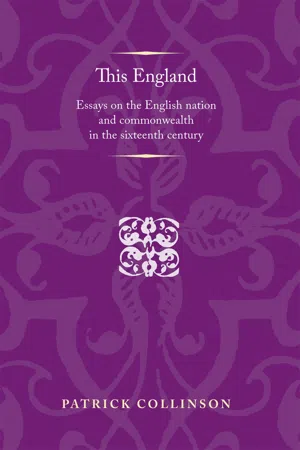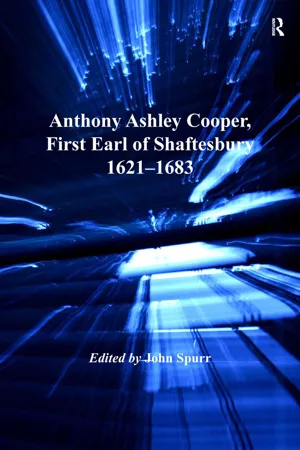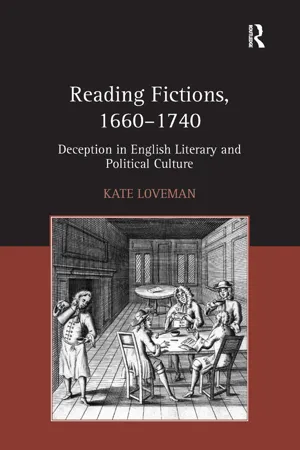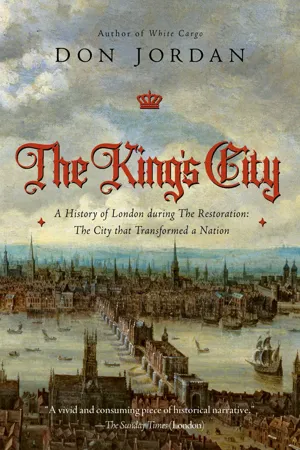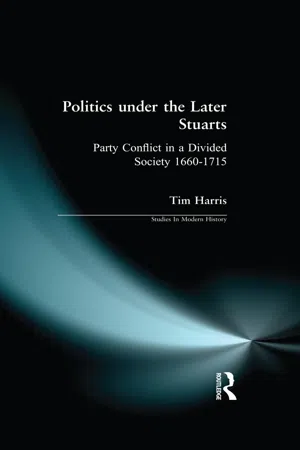History
Exclusion Crisis
The Exclusion Crisis was a political and constitutional crisis in 17th century England, centered around the efforts to exclude James, Duke of York, from the line of succession due to his Catholic faith. The crisis led to intense political divisions and debates over the balance of power between the monarchy and Parliament, ultimately shaping the trajectory of English politics and the Glorious Revolution.
Written by Perlego with AI-assistance
Related key terms
6 Key excerpts on "Exclusion Crisis"
- eBook - ePub
This England
Essays on the English nation and Commonwealth in the sixteenth century
- Patrick Collinson(Author)
- 2013(Publication Date)
- Manchester University Press(Publisher)
My title needs to be explained, and perhaps defended. By ‘the Elizabethan Exclusion Crisis’ I refer to the sustained concern of much of the ‘political nation’ in the reign of Elizabeth I to forestall the accession to the English crown of Mary Queen of Scots; and, indeed, to prevent any other remedy for the dangerous vacuum of an uncertain succession which would threaten the Protestant religious and political settlement and all that it stood for. These contingencies included a royal marriage to a foreign Catholic prince, and in particular to the French duke of Anjou, the last to tango with Elizabeth, in the late 1570s. The formulation ‘Elizabethan Exclusion Crisis’ is not canonical and may not catch on. It is a question whether a crisis can endure for as many as twenty-seven years, which was the time it took finally to put paid to Mary Stuart’s claim in that bloody drawing room at Fotheringhay. (Was the forty-five-year Cold War a ‘crisis’?) But historians do speak of an Elizabethan succession problem, often distinguishing between an ‘early’ (1560s) and ‘late’ (1590s) succession problem. But in truth this was a problem which lasted the entirety of Elizabeth’s reign, exactly the length of the Cold War, only finding a final solution at the moment of her death in 1603. As with the Cold War, the fact that the Exclusion Crisis ended with less of a bang than a whimper has discouraged the legitimate exercise of counterfactual history. For the might-have-beens of the past have their own lessons to tell about the capacities of former societies.‘Exclusion Crisis’ is filched from the inflamed politics of a full century later, the period from 1677–83, which Restoration historians have supposed to have centred on a campaign to exclude from the succession James, duke of York, the brother of Charles II, who had made public his conversion to Catholicism in 1673.1 It may seem perverse to invent an Elizabethan Exclusion Crisis at the very moment when Dr Jonathan Scott invites us to abandon the traditional fixation on a supposed Exclusion Crisis in the reign of Charles II, ‘an historical invention’, he tells us. Instead, we should think of the Restoration crisis, an affair concerned more with the politics of the present under the merry but treacherous monarch than with apprehensions about the future, its content and concern summed up in the title of a famous pamphlet by Andrew Marvell, published in 1677: The Growth of Popery and Arbitrary Government . Concern about the succession was only a part of these fears, and exclusion of the future James II only one of several possible solutions to the problem. So to speak of an Exclusion Crisis is to define a greater whole in respect of only one of its parts; in Scott’s vivid image to dwell upon the horn of the rhinoceros while ignoring the charging beast itself.2 - eBook - ePub
Restoration Politics, Religion and Culture
Britain and Ireland, 1660-1714
- George Southcombe, Grant Tapsell(Authors)
- 2009(Publication Date)
- Bloomsbury Academic(Publisher)
He does not deny that there was a ‘crisis’ in this period, but questions whether the issue of ‘Exclusion’ was really central to it. For Scott this crisis was not so much about who succeeded to the throne after the death of Charles II, but how the later Stuart monarchy used its prerogative powers, as much in contemporaries’ here and now as in their distant future. 5 This, then, was a particular part of the longer term ‘crisis of parliaments’ in the early modern period, one in which MPs and peers self-consciously sought to protect their present status and future existence. 6 This view of a ‘Restoration crisis’ found qualified, but immensely detailed, support in Mark Knights’ reading of the polemical discussion and understanding of the political situation throughout England. What MPs and constituents clashed so vigorously about was a range of issues subsumed under the shorthand title particularly associated with the politician–poet Andrew Marvell: ‘popery and arbitrary government’. 7 Although far from unimportant, ‘exclusion’ in these accounts becomes one part of a much wider political and religious jigsaw. 8 A third challenge to older scholars’ focus on the ‘Exclusion Crisis’ has emerged from a large-scale shift in the historiography of the Restoration period. As late as the mid 1980s there was a general view that the Restoration period was less interesting than the early Stuart period, partly because there seemed to be fewer overt crises. That was what made the Exclusion Crisis so striking. It was the exception to an emerging picture of ‘political stability’ that would be given shape by the Glorious Revolution and its aftermath. 9 But recent researches – notably those by Gary De Krey – have identified numerous Restoration crises: crises about conscience and counsel in the mid and late 1660s, about prerogative power and religious settlement in the early to mid 1670s, and about standing armies in the 1690s - John Spurr, John Spurr(Authors)
- 2016(Publication Date)
- Routledge(Publisher)
38 The remainder of this chapter will consider the participation of Shaftesbury in the promotion of exclusion, in the light of the re-evaluation of the relevance of the exclusion issue by Scott and his fellow-revisionists in the course of the forty-year-long aftermath of the publication of Haley’s biography.V
It has been argued by Scott and others that it is desirable to emphasise the continuing relevance of religion to politics and government. It is not the case that Puritanism ‘peaked’ in the 1650s, and then ran out of steam after 1660. What appear to be manifestations of a more secular outlook in the Restoration period – the Royal Society, the revival of the stage (and the appearance of women upon it), the influence of commercial considerations on foreign policy, the increasing expenditure of all ranks of people on consumer goods, the moral tone of Charles II’s court, the preoccupations recorded by Samuel Pepys in his celebrated Diary – are all misleading. Quarrels over religion were still at the heart of political conflict in the 1660s and 1670s. This conflict, especially in the municipal corporations, frequently took the form of a struggle between the adherents of the Church of England and the adherents of Dissent. Alongside this, the Popish Plot agitation can be interpreted as a genuine ‘popular movement’, more so, indeed, than some other seventeenth-century phenomena which are conventionally described as ‘popular movements’, such as the ‘Levellers’ and ‘Diggers’ of the late 1640s. The Popish Plot cannot be condescendingly written off as an outbreak of mob hysteria sparked off by deluded monomaniacs such as Israel Tonge or by calculating mountebanks and charlatans such as Titus Oates, William Bedloe, Miles Prance, Stephen Dugdale and Stephen College. The plot does seem to have reflected the apprehensions of intelligent and well-informed persons. These persons were wrong, but we can see (with hindsight) why they were wrong. They were, for example, aware of the aggressive and expansionist policies pursued by France, and of the increasingly robust treatment by Louis XIV of his Huguenot subjects.39- eBook - ePub
Reading Fictions, 1660-1740
Deception in English Literary and Political Culture
- Kate Loveman(Author)
- 2016(Publication Date)
- Routledge(Publisher)
The Jesuits, said Oates, were engaged in treasonable conspiracies around the country. In recent months, they had set in train several schemes to assassinate Charles. Mercifully, providence had foiled these regicidal plots, but the life of the king and the security of the nation were in dire peril. 2 These claims were the most sensational news of the decade. They were to be recalled by eighteenth-century historians as one of the great political events of the last age – and, by some, as one of the greatest deceptions. 3 Oates’s allegations seized the public’s imagination, sparking a political crisis involving competing ideas of credibility, history and allegiance. Charges of regicidal Jesuit schemes intensified concern over the position of Charles’s Catholic heir, the Duke of York. In a series of fraught sessions from 1679 to 1681, the House of Commons repeatedly tried to exclude the Duke from the succession. The crisis saw a weakening of Government control over debate and association, particularly in the City of London. The number of print publications surged, with coffee-houses and taverns acting as venues for plotting, dispute and ridicule. Historians have seen in the debates of this period a growing acceptance of the necessity (if not the legitimacy) of appeals to public opinion in politics and the beginnings of a party system. 4 A sense of the ways truth and fiction were contested in this period is essential to contextualise developments in political and literary discourse. At the centre of the Exclusion Crisis were the informers’ testimonies of Catholic and nonconformist conspiracies; in the eyes of contemporaries, a wrong decision about whether these were true or false might ultimately lead to England’s becoming a Catholic kingdom or to another civil war. Contemporaries’ attempts to weigh the credibility of these testimonies are the subject of the first section of this chapter - eBook - ePub
- Don Jordan(Author)
- 2018(Publication Date)
- Pegasus Books(Publisher)
Two Treatises of Government, in which he argued against the view that civil society was best controlled by divinely ordained paternalism, asserting that the only legitimate form of government was byconsent. Locke’s work was in part an answer to Filmer and partly a reaction to the Exclusion Crisis. The political heat around the crisis was intensifying, fuelled by Locke’s patron, Lord Shaftesbury and allies including Lord Russell. In the political upheavals following various attempts to have James removed from the royal line of inheritance, London was further wracked with rumours of plots and counter-plots.It was certainly true that new groups of conspirators had arisen from an unexpected quarter. Far from being in the old Cromwellian mould, they were aristocrats. This was not so strange as it might first appear, for the attack was not on the Crown itself but on the possibility of a Catholic succeeding to the English throne. The aim was to reform the monarchy rather than to destroy it; as Shaftesbury put it, they didn’t want democracy. In 1680 an Exclusion Bill passed the Commons but was defeated in the Lords. The Commons was prepared to consider an alternative, whereby the powers of a Catholic monarch would be limited. Charles refused to consider it. By this time, the London mobs were parading effigies of the Duke of York through the streets.With so much at stake, it is hardly surprising that the government stepped in to censor the theatre. During the period of the Exclusion Crisis many plays, both old and new, were banned. Several of Shakespeare’s history plays dealing with his recurring themes of power and monarchy fell foul of the ban. Plays by Shadwell, a Whig, were banned, as were works by Dryden, a Tory.11The problem was not so much the criticism of monarchy but the fear of incitement of the rabble.12 Quite how a theatre frequented by the well-to-do was likely to pander to the rabble was hard to explain. Dryden was so incensed by his work being caught up in the government’s paranoia that he wrote a public broadside against its actions – a bold action for the poet laureate. Dryden had another reason to feel aggrieved; he had recently written perhaps his greatest work, the political poem Absalom and Achitophel, in which he defended Charles II despite his philandering and castigated his enemies, including the Whig leader Lord Shaftesbury, for not sticking by the monarchy.13 - eBook - ePub
Politics under the Later Stuarts
Party Conflict in a Divided Society 1660-1715
- Tim Harris(Author)
- 2014(Publication Date)
- Routledge(Publisher)
81 The government had even been prepared to offer additional legal safeguards in the advent of a popish King, but these had been rejected by the exclusionists.This Tory stress on the security given to the Protestant religion by Acts of Parliament is worth emphasising, since it is the Whigs who are usually regarded as the champions of Parliament during the Exclusion Crisis. Did not the Tories show themselves in many respects to be enemies of Parliament? The Tories certainly denied the Whig principle of co-ordination, that the King shared his powers with the Lords and Commons: it was ‘a breach upon the best Constitution of Government in the World’, to assert that ‘the soveraign Power lieth in the Commons’.82 They rejected the theory of the ancient constitution, and defended the King’s prerogative power of determining the sitting of Parliament. As the Cambridge scholar, Dr Robert Brady, was to show, Parliaments were created by the Crown in the late-medieval period, and had historically always been dependent upon the Crown for their sitting; the were therefore subordinate to the King, who alone was sovereign.83 Yet most Tories were not against Parliaments per se ; they were just against Whig-dominated Parliaments. What the Tories wanted, as John Verney wrote in July 1679, at the time of the dissolution of the first Exclusion Parliament, was ‘an honest Church of England Parliament’.84 In his Declaration issued in April 1681, explaining why he had dissolved the previous two Parliaments, Charles II expressed his resolve ‘to have frequent Parliaments’, and although he did not in fact fulfil this promise, he clearly recognised that it was something which, not only his opponents, but also his supporters wanted to hear.85 As one Tory newspaper put it at the same time, ‘I hope we shall have a Parliament yet that will heal all’.86 One pamphleteer claimed he desired ‘as heartily as any one in England, the frequent Meetings of Parliament’, though he cautioned that ‘experience tells us, That Parliaments may Erre as well as Kings’.87 Tories continued to hope for a Parliament well into the period of the Tory Reaction which followed the defeat of Exclusion. In January 1683 one correspondent, commenting how the situation in London was much better now than it had been for a long time, concluded by saying ‘we want only A Parliament that we may trust’.88
Index pages curate the most relevant extracts from our library of academic textbooks. They’ve been created using an in-house natural language model (NLM), each adding context and meaning to key research topics.
